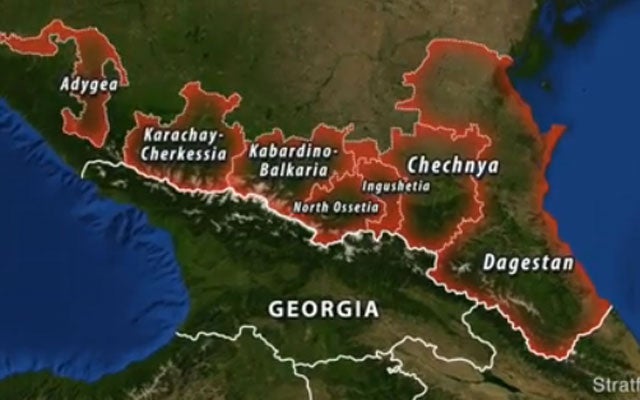 The Boston Marathon bombers have brought greater attention to Russia’s volatile North Caucasus, their ancestral home. As painful their heinous acts are, however, the bombers’ actions are just a footnote to the history of insurgency and connections to global Islamist networks in the North Caucasus.
The Boston Marathon bombers have brought greater attention to Russia’s volatile North Caucasus, their ancestral home. As painful their heinous acts are, however, the bombers’ actions are just a footnote to the history of insurgency and connections to global Islamist networks in the North Caucasus.
The North Caucasus has a long history of violence and fighting against Russia stretching back over 200 years. Russia’s expansion into the North Caucasus in the 19th century met with decades-long resistance from the local mountainous Muslim nations. Despite Russian military victories and control, bought with rivers of blood and mass ethnic cleansings, the inhabitants of the North Caucasus maintained their distinct Islamic identity due to their tenacity and the rough terrain of the region.
After using aerial bombings and chemical weapons against the Muslim mountaineers in the 1920s, Stalin deported hundreds of thousands of Chechen and Ingush from their North Caucasus homeland to Central Asia in 1944. After Stalin’s death, many of them returned home in 1956.
Chechnya declared its independence after the collapse of the Soviet Union in 1991, demanding the sovereignty that other former Soviet republics received. However, in 1994, President Boris Yeltsin authorized military force to suppress the separatists, and the ensuing hostilities—the First and Second Chechen Wars—were brutal. Foreign Islamists exploited the vacuum of the Second Chechen War and radicalized the Chechens. This marked the start of the region’s ties to the global Islamist movement.
Several top-level operatives from al-Qaeda entered the North Caucasus in the 1990s, including Al-Moganned and Ibn Al-Khattab, Saudi-born emissaries of al-Qaeda. Collectively, they steered the conflict toward radicalism, because Islamists viewed the North Caucasus as “infidel-occupied territories” and their struggle for independence as a defensive jihad (holy war). The draw of the North Caucasus to foreign Islamists was so great that it attracted current al-Qaeda head Ayman al-Zawahiri in 1997. He was arrested and released by the Russians after six months in jail.
By 2004, Russia established nominal control over the region, but the insurgency remained, and it turned to terrorism. Shamil Basayev, the self-styled emir (military commander) of the Caucasus Emirate, was the radical organizer behind the major terrorist attacks in Russia between 1999 and 2006. After Basayev’s demise in 2006, Doku Umarov became the leader.
According to the Global Terrorism database, Russia ranked seventh in the world in the number of suicide attacks between 1991 and 2008. The more than 1,100 terrorist attacks resulted in more than 3,100 deaths and 5,100 injuries. Some of the most notable attacks include:
- The 2002 Dubrovka Theater attack in Moscow, which left 130 dead;
- The Beslan school hostage massacre in 2004, which left 331 dead, many of whom were children;
- Train bombings on the Nevsky Express train in 2007 and 2009;
- The Moscow Metro suicide bombing in 2010;
- The suicide bombing at Domodedovo Airport in 2011, which killed 36 people and injured more than 180.
This insurgency is one of the greatest internal threats to Russia. However, as the Boston terrorists’ ties to the global Islamist movement show, it also has become a threat to the United States.
The U.S. government should work with its friends and allies in the region, such as Azerbaijan, Georgia, and Turkey; with European countries; and with Russia when necessary to reduce and isolate the Islamist threat from the North Caucasus.






















